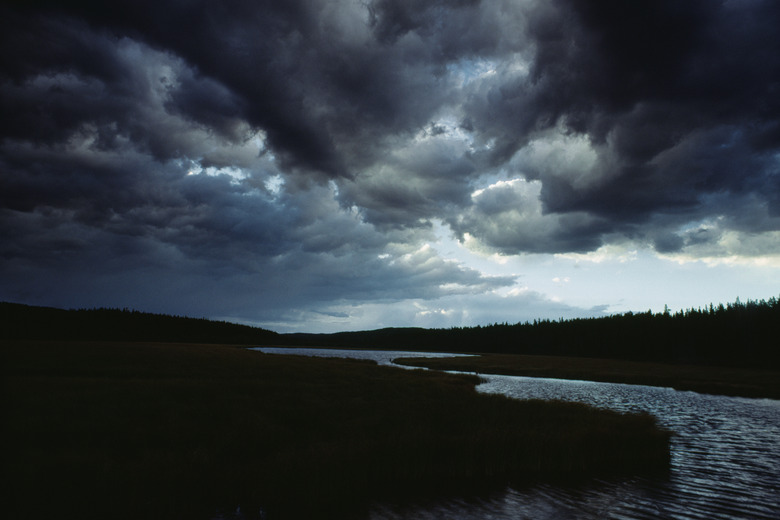How Does Air Mass Influence Climate?
An air mass is a large unit of the lower atmosphere defined by common physical characteristics, such as temperature and humidity, at any given altitude, and one that remains discrete and identifiable as it moves. These giant parcels — often better than 1,600 kilometers (1,000 miles) broad — exert significant meteorological and climatic influence, transporting characteristics of their regions of origin through the territory they move over. Thresholds of adjacent air masses also form fronts, along which much of the world's major weather action travels.
Air-Mass Basics
Air-Mass Basics
The zones that birth air masses, which are most prevalent in the tropics, subtropics and high latitudes, are called "source regions." They're typically areas of relatively uniform surface — tracts of ocean, desert or snow-covered plains, for example — which experience generally weak winds, the kind of stable conditions that allow parcels of atmosphere to assume physical characteristics from the underlying water or land. These source regions and their prevailing temperature, humidity and stability features help classify the world's major air masses, which include:
- continental-polar
- or cP
- maritime-polar
- or mP
- continental-tropical
- cT
- maritime-tropical
- mT
- Arctic/Antarctic
- A
Movement
Movement
An air mass may sit over its source region for long periods of time, or it may migrate. An air mass on the move begins to transform as it passes over new landscapes, while at the same time retaining enough of its original conditions to alter local weather. For example, a cP air mass originating from the tundra of northern Canada may push southward during the winter. It brings frigid temperatures to the central United States, even as it warms up somewhat on its journey across lower latitudes. While dry in its source region, such an air mass often picks up substantial moisture during an early-winter transit of the Great Lakes, allowing it to dump so-called lake effect snow on leeward coasts. Different air masses don't easily merge with one another; they clash uneasily in the atmospheric frontiers called fronts.
Weather and Climate
Weather and Climate
Weather describes the day-to-day meteorological conditions — precipitation, temperature, wind and the like — of a certain site. A thunderstorm along a frontal boundary is a weather event. Climate, meanwhile, represents the long-term annual patterns of those meteorological conditions — the seasonal fluctuations of rainfall in a given region, for example. While the major, readily observable effects of air masses are mostly in the realm of daily weather, the reliability of air-mass incursions in many regions make them important contributors to regional climate conditions.
Precipitation and Temperature
Precipitation and Temperature
The climates of most regions worldwide are affected by air masses. For example, maritime-tropical air sourced over warm waters of the Atlantic Ocean, Caribbean Sea and Gulf of Mexico, primarily between 10 and 30 degrees north of latitude, is the main contributor of precipitation for much of North America east of the Rocky Mountains. It's also the cause of the persistent humidity typical of that big region's summer season. In the Pacific Northwest, maritime-polar air tracking inland from the Aleutian Low in the winter supplies the heavy mountain rain and snowfall that nourish vast temperate rainforests and extensive alpine glaciers. Such maritime air masses also contribute to a moderating climatic influence on coastal temperatures, as oceans heat up and cool down more slowly and less dramatically than landmasses.
Cyclones and Anticyclones
Cyclones and Anticyclones
Where polar and tropical air masses abut in the mid-latitudes, prevailing westerly winds funnel along alternating low- and high-pressure centers called cyclones and anticyclones, respectively. Stormy cyclones form near the air-mass fronts. Anticyclones represent stable, singular air masses, and are typically larger and more sluggish than cyclones. These may be forces of weather, but their regularity gives them climatic significance: The mixing of air masses achieved along the alternating warm and cold fronts of a mid-latitude cyclone is part of the process by which the heat of the lower latitudes is transferred poleward.
Cite This Article
MLA
Shaw, Ethan. "How Does Air Mass Influence Climate?" sciencing.com, https://www.sciencing.com/air-mass-influence-climate-23966/. 13 March 2018.
APA
Shaw, Ethan. (2018, March 13). How Does Air Mass Influence Climate?. sciencing.com. Retrieved from https://www.sciencing.com/air-mass-influence-climate-23966/
Chicago
Shaw, Ethan. How Does Air Mass Influence Climate? last modified March 24, 2022. https://www.sciencing.com/air-mass-influence-climate-23966/
